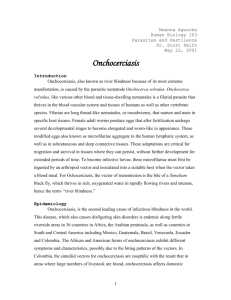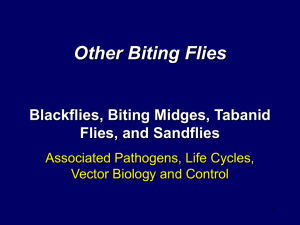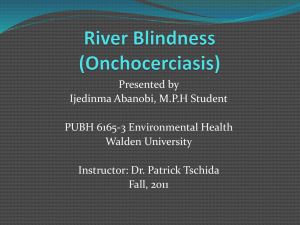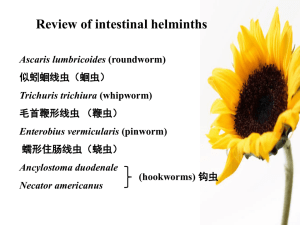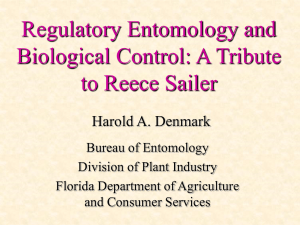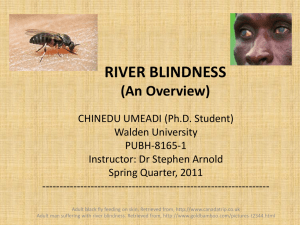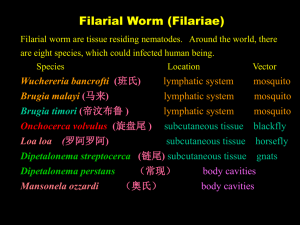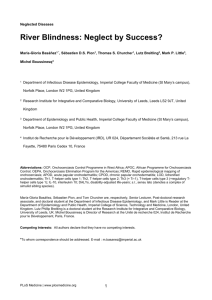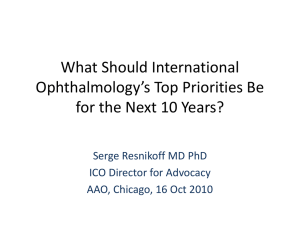Onchocerciasis
advertisement
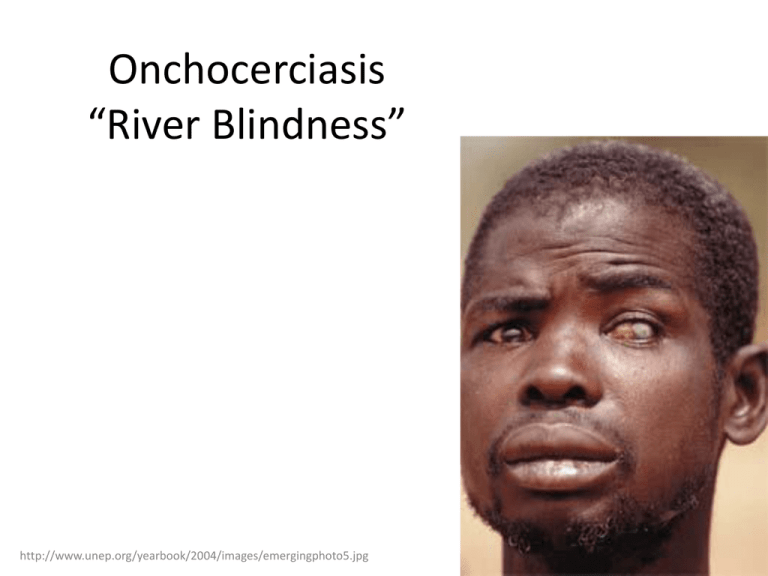
Onchocerciasis “River Blindness” http://www.unep.org/yearbook/2004/images/emergingphoto5.jpg Onchocerciasis “River Blindness” Second leading infectious cause of blindness in the world http://www.unep.org/yearbook/2004/images/emergingphoto5.jpg Onchocerciasis “River Blindness” Second leading infectious cause of blindness in the world Also causes skin lesions and skin nodules and intense itching http://www.unep.org/yearbook/2004/images/emergingphoto5.jpg More than 30 million people worldwide are infected with Onchocerciasis http://www.stanford.edu/class/humbio103/ParaSites2004/Onchocerciasis/worldmap.png Transmission is concentrated in central Africa and Latin America Over 90% of all cases occur in Africa http://www.stanford.edu/class/humbio103/ParaSites2004/Onchocerciasis/worldmap.png Infection caused by the parasitic worm Onchocerca volvulus Adult worms http://www.icp.ucl.ac.be/~opperd/parasites/images/worms.jpg http://www.dpd.cdc.gov/dpdx/HTML/Filariasis.htm Microfilariae of O. volvulus from a skin nodule of a patient from Zambia Infection spreads from person to person by the bite of an infected Simulium blackfly WHO/TDR/Stammers Human Stages 1. Infected blackfly introduces third stage larvae onto the skin of the host, then they penetrate the skin Human Stages 1. Infected blackfly introduces third stage larvae onto the skin of the host, then they penetrate the skin 2. Larvae develop into adults in subcutaneous tissue Human Stages 3. Adults produce microfilariae Human Stages 3. Adults produce microfilariae 4. A blackfly ingests microfilariae during blood meal Blackfly Stages 5. After ingestion, microfilariae migrate to the thoracic muscles of the blackfly Blackfly Stages 6. There they develop into stage 1 larvae, and then stage 3 larvae 5. After ingestion, microfilariae migrate to the thoracic muscles of the blackfly Blackfly Stages 7. 3rd stage larvae can infect another human when the blackfly takes a blood meal 6. There they develop into stage 1 larvae, and then stage 3 larvae 5. After ingestion, microfilariae migrate to the thoracic muscles of the blackfly But…how does this cause blindness and other symptoms? But…how does this cause blindness and other symptoms? As mentioned earlier, adult worms produce microfilariae in the human stages 3. Adults produce microfilariae– up to 1000 per day! Microfilariae induce intense inflammatory responses, especially upon their death http://www.icp.ucl.ac.be/~opperd/parasites/onch1.html Microfilariae induce intense inflammatory responses, especially upon their death Some microfilariae will migrate throughout the upper layers of the skin, causing large nodules to form under skin… http://www.icp.ucl.ac.be/~opperd/parasites/onch1.html …and skin rashes and lesions, known as “leopard skin” http://www.icp.ucl.ac.be/~opperd/parasites/onch1.html Others migrate to the surface of the cornea, causing sclerosing Keratitis to occur http://www.icp.ucl.ac.be/~opperd/parasites/onch1.html Others migrate to the surface of the cornea, causing sclerosing Keratitis to occur The infected area becomes increasingly opaque with more microfilariae http://www.icp.ucl.ac.be/~opperd/parasites/onch1.html Ivermectin is the drug of choice for Onchocerciasis • Paralyzes and kills microfilariae of O. volvulus http://3.bp.blogspot.com/-V4h6xT_GaKM/TwcIXiInfaI/AAAAAAAAuAg/Yx6UAxhqif0/s1600/Merck-%2526-Co-Logo.jpg Ivermectin is the drug of choice for Onchocerciasis • Paralyzes and kills microfilariae of O. volvulus • Doesn’t kill adult females, but prevents them from producing any offspring http://3.bp.blogspot.com/-V4h6xT_GaKM/TwcIXiInfaI/AAAAAAAAuAg/Yx6UAxhqif0/s1600/Merck-%2526-Co-Logo.jpg Ivermectin is the drug of choice for Onchocerciasis • Paralyzes and kills microfilariae of O. volvulus • Doesn’t kill adult females, but prevents them from producing any offspring – Thus, prevents transmission http://3.bp.blogspot.com/-V4h6xT_GaKM/TwcIXiInfaI/AAAAAAAAuAg/Yx6UAxhqif0/s1600/Merck-%2526-Co-Logo.jpg Studies in hyperendemic foci have shown the effectiveness of Ivermectin Has anyone done anything about this? Has anyone done anything about this? Onchocerciasis Control Programme (OCP) was launched in 1974 • Launched by WHO http://www.who.int/blindness/partnerships/onchocerciasis_OCP/en/index.html Goals of OCP 1.Control blackfly populations 2.Use Ivermectin to treat infected people Controlling blackfly populations involved interrupting transmission by eliminating the blackfly vector http://www.icp.ucl.ac.be/~opperd/parasites/onch1.html Controlling blackfly populations involved interrupting transmission by eliminating the blackfly vector Helicopters are used to spray insecticides on rivers and fast moving waters (Simulium breeding sites) http://www.icp.ucl.ac.be/~opperd/parasites/onch1.html OCP was a huge success and ended in 2002 African Programme for Onchocerciasis Control (1995) Onchocerciasis Elimination Programme for the Americas (1992) http://ars.els-cdn.com/content/image/1-s2.0-S1471492201021122-gr1.jpg References Diawara L, Traoré MO, Badji A, Bissan Y, Doumbia K, et al. (2009) Feasibility of Onchocerciasis Elimination with Ivermectin Treatment in Endemic Foci in Africa: First Evidence from Studies in Mali and Senegal. PLoS Negl Trop Dis 3(7): e497. doi:10.1371/journal.pntd.0000497 "DPDx - Filariasis." DPDx – Filariasis. Web. 05 Nov. 2012. <http://www.dpd.cdc.gov/dpdx/HTML/Filariasis.htm>. "Onchocerciasis (River Blindness)." Stanford.edu. Web. 05 Nov. 2012. <http://www.stanford.edu/class/humbio103/ParaSites2004/Onchocerciasis/index.htm>. "Priority Eye Diseases." WHO. Web. 05 Nov. 2012. <http://www.who.int/blindness/causes/priority/en/index3.html>.
